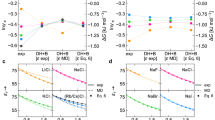Abstract
Aqueous electrolyte solutions play an important role in many electrophysical and chemical processes in aerospace technology and industrial applications. As noncovalent interactions, the interactions between ions are crucially important for biomolecular structures as well (protein structure folding, molecular level processes followed by ionic pair correlations, the formation of flexible hydrate shells, and so on). Specifically, ions (cations and anions with the same valence charges) can form stable pairs if their sizes match. The formation of ionic pairs can substantially affect the thermodynamic stabilities of proteins in the alkali salts physiologically present in the human body. Research aims and problems impose severe demands on readjustments of the ionic force fields and potential parameters developed to describe aqueous solutions and electrolytic systems. Ionic solutions and their interaction with biomolecules have been observed for over 100 years [1], but the behavior of such solutions remains poorly studied today. New data obtained in this work deals with parameterization strategies and adjustments for the ionic force fields of the alkali cations and halide anions that should be helpful in biomolecular research. Using molecular dynamics (MD) models, four electrolytic systems (HCl-H2O, LiCl-H2O, NaCl-H2O, and KCl-H2O) are investigated as binary mixtures of water and cations and anions, respectively. The intermolecular interaction parameters are varied for two of the four model electrolytes (HCl-H2O and NaCl-H2O) to simulate the possibility of different ionic shells forming during interaction with water. It is found that varying the potential parameters strongly affects the dynamic and structural characteristics of electrolyte systems. MD simulations are performed in the temperature range of 300 to 600 K with a step of 50 K. MD simulations for all electrolyte models (HCl-H2O, LiCl-H2O, NaCl-H2O, KCl-H2O) are also conducted for different molar fractions of electrolyte concentration: 16, 8, and 1 mol/kg. Energies of diffusion activation are calculated using the Arrhenius equation, thereby constructing temperature dependence graphs of diffusion coefficients for all four electrolyte systems. The observed diffusion properties of the electrolyte systems are found to correlate well with the energy and structural radial distribution data.
Similar content being viewed by others
References
K. D. Collins, Proc. Natl. Acad. Sci. USA 92, 5553 (1995).
R. L. Baldwin, Biophys J. 71, 2056 (1996).
M. G. Cacace, E. M. Landau, and J. J. Ramsden, Q. Rev. Biophys. 30, 241 (1997).
W. Kunz, P. Lo Nostro, and B. W. Ninham, J. Colloid Interface Sci. 9, 1 (2004).
Y. J. Zhang and P. S. Cremer, Chem. Biol. 10, 658 (2006).
P. Qian and Zh. Zh. Yang, Sci. China, Ser. B: Chem. 50, 190 (2012).
B. Hess and N. F. A. van der Vegt, Proc. Natl. Acad. Sci. 106, 13296 (2009).
I. S. Joung, T. Luchko, and D. A. Case, J. Chem. Phys 138, 044103 (2013).
D. Horinek, A. Herz, L. Vrbka, et al., Chem. Phys. Lett. 479, 173 (2009).
C. D. Wick and L. X. Danga, J. Chem. Phys. 125, 024706 (2006).
E. Sanz and C. Vega, J. Chem. Phys. 126, 014507 (2007).
I. V. Khavrutskii, J. Dzubiell, and J. A. McCammon, J. Chem. Phys. 128, 044106 (2008).
O. T. Cummings and C. D. Wick, J. Chem. Phys. 139, 064708 (2013).
F. Mou ka, I. Nezbeda, and W. R. Smith, J. Chem. Phys. 139, 124505 (2013).
T. E. Cheatham III and M. A. Young, Biopolymers 56, 232 (2000–2001).
S. Koneshan, J. C. Rasaiah, R. M. Lynden-Bell, and S. H. Lee, J. Phys. Chem. B 102, 4193 (1998).
J. C. Rasaiah and R. M. Lynden-Bell, Phil. Trans. R. Soc. London A 359, 1545 (2001).
K. Yui, M. Sakuma, and T. Funazukuri, Fluid Phase Equilib. 297, 227 (2010).
H. J. C. Berendsen, J. R. Grigera, and T. P. Straatsma, J. Phys. Chem. 91, 6269 (1987).
G. W. Robinson, S. Singh, S.-B. Zhu, and M. W. Evans, World Sci. Ser. Contemp. Chem. Phys. 9, 528 (1996).
P. G. Kusalik and I. M. Svishchev, Science 265, 1219 (1994).
C. W. Yong, STFCs Comput. Sci. Eng. Departm. (CSED), 38 (2010).
T. R. Forester and W. Smith, J. Mol. Graphics 14(3), 136 (1996).
B. R. Brooks, C. L. Brooks, A. D. Mackerell, Jr., L. Nilsson, R.J. Petrella, B. Roux, Y. Won, G. Archontis, C. Bartels, S. Boresch, A. Caflisch, L. Caves, Q. Cui, A. R. Dinner, M. Feig, S. Fischer, J. Gao, M. Hodoscek, W. Im, K. Kuczera, T. Lazaridis, J. Ma, V. Ovchinnikov, E. Paci, R. W. Pastor, C. B. Post, J. Z. Pu, M. Schaefer, B. Tidor, R.M. Venable, H. L. Woodcock, X. Wu, W. Yang, D. M. York, and M. Karplus, J. Comput. Chem. 30, 1545 (2009).
M. Horsch, S. Becker, J. M. Castillo, S. Deublein, A. Froscher, S. Reiser, S. Werth, J. Vrabec, and H. Hasse, arxiv:1305.4048v1.
L. Xin, G. L. Dong, and Y. Z. Zhi, Sci. China Ser. B: Chem. 51, 1221 (2008).
C. Caleroa, J. Faraudoa, and M. Aguilella-Arzob, Mol. Simul. 37, 123 (2011).
T. Ikeda, M. Boero, and K. Terakura, J. Chem. Phys. 126, 034501 (2007).
W. Li, C. Chen, and J. Yang, Heat Tran. Asian Res. 37, 86 (2008).
J. C. Warner, Ann. Acad. Sci. N.Y. 39, 345 (1939).
L. T. Vlaev, S. D. Genieva, and M. P. Tavlieva, J. Struct. Chem. 44, 995 (2003).
H. F. Shurvell, J. Chem. Educat. 43, 555 (1966).
Author information
Authors and Affiliations
Corresponding author
Additional information
Published in Russian in Zhurnal Fizicheskoi Khimii, 2014, Vol. 88, No. 12, pp. 2017–2027.
This article was translated by the authors.
Rights and permissions
About this article
Cite this article
Khalansky, D., Popova, E., Gladyshev, P. et al. A molecular dynamic model for analyzing concentrations of electrolytes: Fractional molar dependences of microstructure properties. Russ. J. Phys. Chem. 88, 2225–2235 (2014). https://doi.org/10.1134/S0036024414120139
Received:
Published:
Issue Date:
DOI: https://doi.org/10.1134/S0036024414120139



